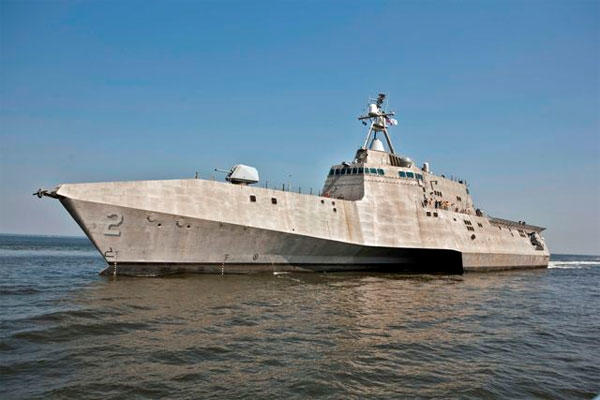The U.S. Navy is preparing to accept delivery of four more of its shallow-water Littoral Combat Ships between now and February of next year, effectively doubling its current fleet size of the ships and paving the way for more deployments.
On Tuesday, the sea service formally accepted delivery of the USS Jackson (LCS 6) during a ceremony at the Austal USA shipyard in Mobile, Alabama.
Next, it to receive the the USS Milwaukee (LCS 5) in October of this year and the USS Montgomery (LCS 8) in December of this year, Naval Sea Systems Command spokesman Chris Johnson explained.
Then, the Navy expects to accept delivery of the USS Detroit (LCS 7) in February of next year, he added.
"By early next year, the Navy will be operating eight littoral combat ships and we'll be accepting four more by the end of 2016," Johnson told Military.com. “The Navy will continue to accept ships at that rate for the next several years making the LCS class the second largest surface combatant class in the fleet and the key to our ability to operate in shallow, coastal waterways around the world."
Related Video
Navy officials expressed enthusiasm about Tuesday’s arrival of the USS Jackson, which will soon bring the total operational number of LCS ships up to five.
"We are pleased to receive the future USS Jackson into the LCS class," Capt. Warren Buller, commander of Littoral Combat Ship Squadron One, said in a written statement. "Jackson will operate out of Mayport, Florida, while conducting full ship shock trials, prior to joining her sister littoral combat ships in their homeport of San Diego in late 2016."
Following commissioning and shock trials, Jackson will be based in San Diego with her sister ships USS Freedom (LCS 1), USS Independence (LCS 2), USS Fort Worth (LCS 3) and the USS Coronado (LCS 4).
"Today marks a significant milestone in the life of the future USS Jackson, an exceptional ship which will conduct anti-submarine, surface and mine countermeasure operations around the globe with ever increasing mission package capability," LCS program manager Capt. Tom Anderson, said in a statement. "It also marks a significant milestone for the LCS program, as the first of 20 LCS block buy ships delivers to the Navy. It is exciting to see these capable, yet affordable, ships transitioning from serial production to serial delivery."
The arrival of four new vessels comes at a time when the service is making progress with improvements to the platform following the initial LCS deployments.
The USS Freedom deployed in the Pacific theater in 2013. The ship recently entered a three-to-four-month dry dock maintenance period wherein it will receive a series of wide-ranging upgrades and repairs. Some of the activities will include new servers, computer networks and updated software, along with improved equipment such as a seawater cooling system, air compressor and communications antenna, among other items, Capt. Scott Pratt, Program Manager for Fleet Introduction and Sustainment, LCS, told Military.com in an interview earlier this summer.
“There are 34 alterations being done on the ship as part of this maintenance availability. These changes are comprised of things that will increase reliability," he said at the time.
The USS Freedom is also getting back-fitted with the same medium pressure air compressor that is now on the USS Fort Worth, currently deployed in the Pacific theater. The compressors are used to start the diesel engines and they also provide air throughout the ship, service officials said.
During its initial deployment in 2013 to Singapore and areas in the South China Sea, the USS Freedom experienced a wide range of technical and reliability problems that resulted in a series of short and long-term fixes. For instance, the ship experienced a temporary power outage while on route to Guam. It also experienced issues with a corroded cable, a faulty air compressor and so-called ship service diesel generators, officials said.
Now, along with improvements to the ship’s air compressor, other adjustments during the maintenance period for the USS Freedom include work on the sea water cooling system and communications antenna. Some of the improvements were put in place for construction and development of LCS 3, LCS 5 and others.
The littoral combat ship was designed as a multi-mission shallow water platform able reach areas and port inaccessible to larger-draft ships.
The platform has been the focus of some criticism and controversy. Lawmakers, analysts and members of the Navy have said the ships are not survivable enough in a fast-evolving world of surface warfare threats. Proponents have maintained that the LCS class is designed to defeat threats in coastal waters, where increasingly capable submarines, mines, and swarming small craft operate.
Nevertheless, the concerns have led the Pentagon and the Navy to develop a new LCS variant, now called a Frigate, designed to capitalize upon the benefits of the LCS platform while making it more lethal and survivable. The particular composition of technologies and weapons for these new ships is now in the process of taking shape.
-- Kris Osborn can be reached at kris.osborn@military.com



























